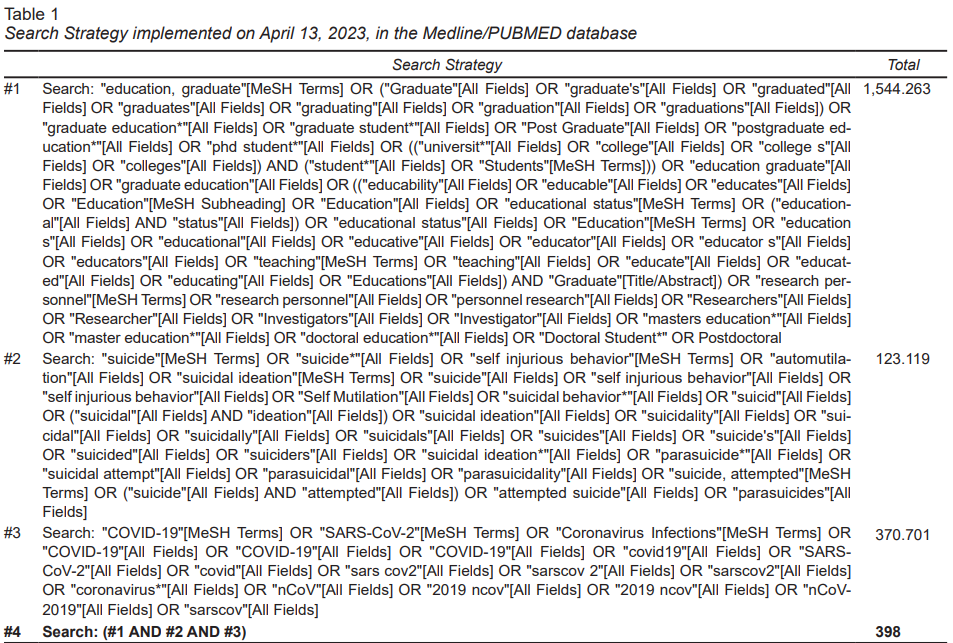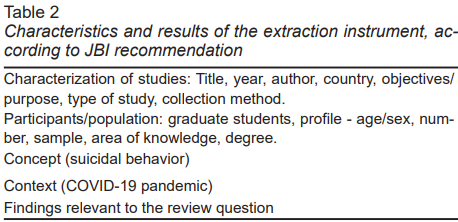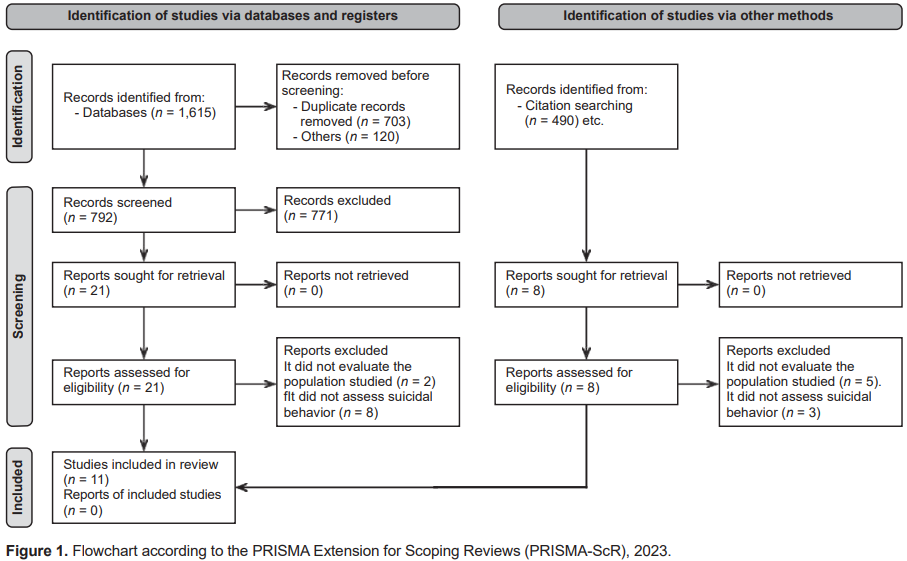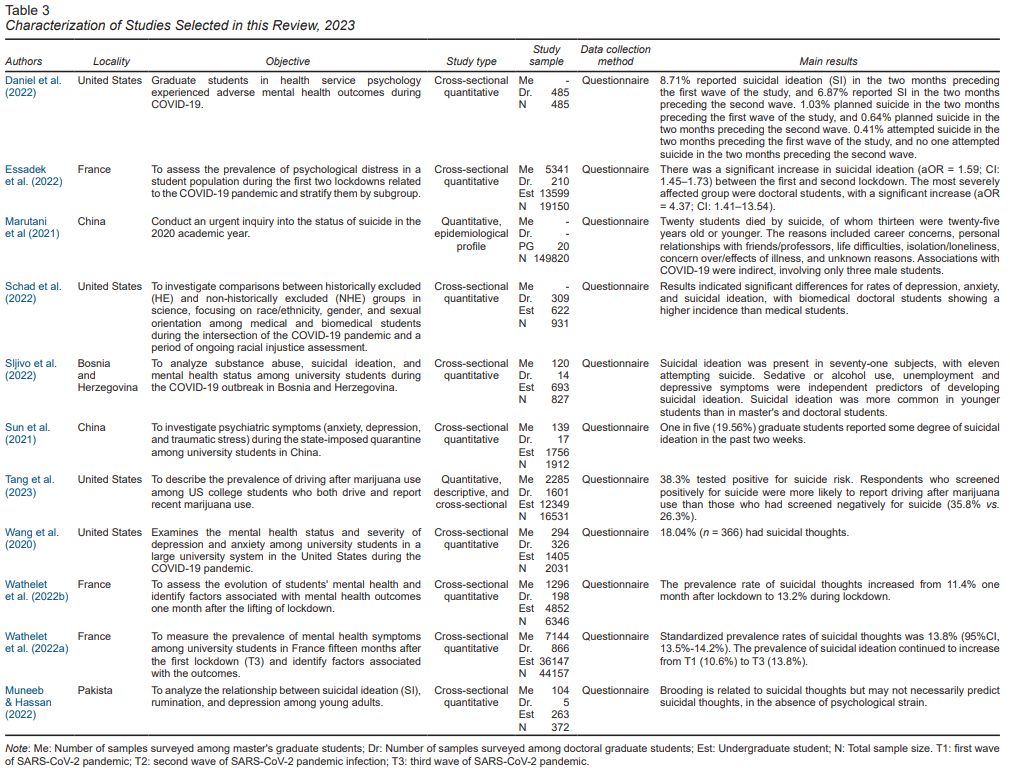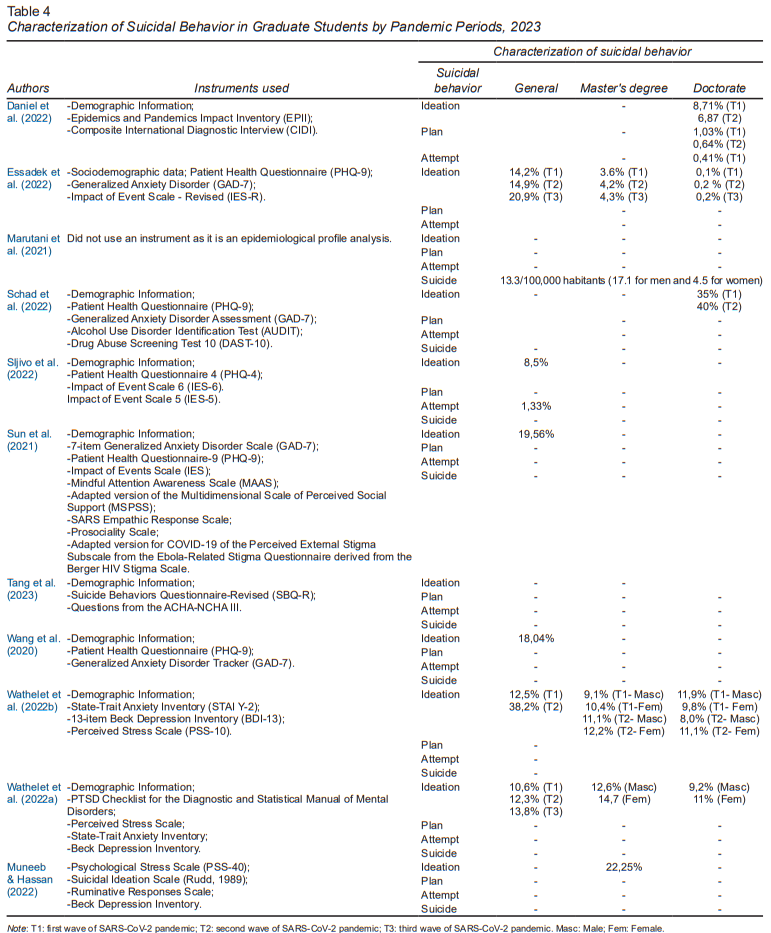INTRODUCTION
Suicidal behavior encompasses a desire to hasten death, indirect self-destructive behavior, parasuicide, deliberate self-harm, suicide attempt, self-mutilation, and suicide (Goodfellow et al., 2019; 2018). According to the World Health Organization [WHO] (2021), suicide is considered a global public health issue, with further studies being required on this phenomenon.
Health emergencies influence mental health. Situations or environments of social isolation to contain the rapid progression of severe acute respiratory syndromes contribute to increased concern about the short- and long-term impacts on mental health (MRC Centre for Global Infectious Disease Analysis, 2020). On December 31, 2019, the World Health Organization (WHO) was alerted to several cases of pneumonia in the city of Wuhan, Hubei province, in China. The virus was officially named SARS-CoV-2, while the disease was called COVID-19 (Liu et al., 2020). On January 30, 2020, WHO declared that the outbreak of the new coronavirus constituted a public health emergency of international concern. On March 11, 2020, COVID-19 was characterized by WHO as a pandemic (Pan American Health Organization [PAHO], 2022). On May 5, 2023, the end of the public health emergency of international concern related to COVID-19 was declared (PAHO, 2023).
COVID-19 spread rapidly across the world. Epidemiological data demonstrated that the SARS-CoV-2 virus was transmitted by droplets, resulting in a swift increase in new cases and a global outbreak. On March 11, 2020, the World Health Organization declared the SARS-CoV-2 outbreak a global pandemic (Bordallo et al., 2020; Silveira et al., 2020).
The COVID-19 pandemic has impacted the everyday lives of people worldwide. Measures were required to address the infection. Changes in social behavior occurred as a result of the implementation of lockdown as a means of containing mass infection in certain countries, causing psychological, environmental, political, and economic effects worldwide (Barcelos et al., 2021). Homes became the setting for online classes, changing from merely residences to schools and workplaces (Mascaro, 2020).
In this scenario, the Pan American Health Organization (PAHO) warned that the COVID-19 pandemic had exacerbated risk factors associated with suicidal behaviors (PAHO, 2021; 2022). Although having a mental disorder is already a risk factor for suicidal behavior, this was exacerbated by the COVID-19 pandemic. Nevertheless, scope review indicates that studies exploring the correlation between suicidal behavior and the outbreak of the pandemic remain controversial (Barlattani et al., 2023).
Due to the changes it caused, the pandemic has led to the emergence of stress-related anxiety and depressive symptoms that can persist for long periods. These symptoms give rise to risky behavior linked to a sense of hopelessness about the near future (Giamattey et al., 2022). Moreover, it has been observed that the COVID-19 pandemic has increased suicide risk factors, such as job loss and economic hardship, trauma, abuse, and mental disorders, as well as creating barriers to accessing healthcare (PAHO, 2021).
Within the context of the COVID-19 pandemic, graduate students warrant attention due to their vulnerability to mental health issues. These issues may be linked to the exploitation of academics class and the lack of research grants or the limited funding for research in recent years (Silva, 2022). This scenario may be forcing graduate students to find new ways of funding their scientific research.
Moreover, the learning environment in which students are immersed is often characterized by internal institutional competition geared towards the private interests of universities, with the potential to become a distressing, hostile atmosphere. The extraction of scientific output in the organic process may also be linked to mental health issues. These situations are intensified for graduate students as emphasis is placed on the assessments of quantitative indicators for each graduate program (Cesar et al., 2018).
The production of scientific research and the development of new technologies, both soft and hard, are primarily driven by graduate programs. The lack of resources for funding these research projects negatively impacts the lives and health of students, as it may jeopardize the development of their projects, potentially leading to frustration, mental distress, and suicidal behavior (Anjos & Rodrigues, 2019; Santos et al., 2020).
During the COVID-19 pandemic, the above aspects may have been exacerbated by social distancing, combined with intense demands for scientific production, exhausting work schedules, unemployment, or reliance on a scholarship requiring exclusive dedication, since it is the sole source of income for these researchers (Silva & Barbosa, 2019; Silva et al., 2019).
A study of 565 graduate students conducted between August and September 2019 (prior to the onset of the COVID-19 pandemic) identified a high prevalence of current suicide risk among graduates and a significant association of this risk with demographic, socioeconomic, academic, and health variables (Abreu et al., 2021). According to the Pan American Health Organization, the pandemic has increased suicide risk factors, such as job loss and economic hardship, trauma and abuse, mental disorders, and barriers to healthcare access (PAHO, 2021). However, it is important to note that, while Pirkis et al. (2021) emphasize the need to act quickly to prevent the long-term adverse effects of the pandemic on suicide, our study seeks to provide additional insights into suicidal behavior in the context of the pandemic. The literature search conducted complements and extends the conclusions of Pirkis et al. (2021), emphasizing the importance of assertive measures, such as strengthening mental health services and mitigating the risk of suicide after the pandemic.
The decision to use scoping review arose from the need to map studies on suicidal behavior among graduate students during the pandemic. The scoping review aims to provide a critical assessment of the methodological quality and significance of the results. It therefore makes it possible to visualize all the studies identified without excluding them, even in the case of studies with lower methodological quality. The scoping review is a method created by the Joanna Briggs Institute (JBI) to map scientific evidence in a specific area of knowledge, and to identify knowledge gaps for discussion and inform future research (Tricco et al., 2018; Peters et al., 2020).
A preliminary search was conducted in January 2023 in the JBI Evidence Synthesis, Open Science Framework (OSF), Cochrane Library, The International Prospective Register of Systematic Reviews (PROSPERO), and the Medical Literature Analysis and Retrieval System Online (MEDLINE/PubMed). No completed or ongoing systematic review or scoping review was found.
METHOD
This scoping review followed the methodological recommendations of the JBI Manual, based on the theoretical framework of Peters et al. (2020). To ensure transparency, a preliminary protocol was developed and registered on April 17, 2023, in the Open Science Framework (OSF) (Leite et al., 2023). The protocol outlines the objectives, research questions, and eligibility criteria for studies, and the methodological steps planned for the review.
The guidelines outlined in the Preferred Reporting Items for Systematic reviews and Meta-Analyses Extension for Scoping Reviews (PRISMA-ScR) checklist were followed (Page et al., 2021) to ensure the quality and transparency of the writing of this article.
Review Question
The research question was guided by the PCC strategy (P: population, C: concept, and C: context) following the JBI Manual (Peters et al., 2020), with “P” being graduate students, “C” being suicidal behavior, and “C” being the COVID-19 pandemic.
The review question is what is the scientific evidence of suicidal behavior in graduate students in the context of the COVID-19 pandemic?
Eligibility criteria
Participants
The review considered studies that included graduate students. Graduate programs encompass master’s and doctoral programs open to candidates with undergraduate degrees who meet the requirements of educational institutions and the selection criteria outlined in announcements for student applications (Ministério da Educação, 1996).
Concept
This review included documents reporting suicidal behavior in graduate students. Suicidal behavior encompasses a desire to hasten death, indirect self-destructive behavior, parasuicide, deliberate self-harm, suicide attempt, self-mutilation, and suicide (Goodfellow et al., 2019; Goodfellow et al., 2018).
Context
On December 31, 2019, the World Health Organization (WHO) warned of a new coronavirus responsible for causing the COVID-19 disease, which subsequently became a public health emergency of international concern (PAHO, 2022).
Types of sources
The review considered primary research studies with quantitative or qualitative designs. Abstracts of presentations and conferences, systematic reviews, and literature reviews were excluded.
The database search was conducted in English, because most international scientific journals require an English version of the abstract and keywords, ensuring that articles in other languages can be selected through this search. There was a limitation on publication dates, with articles considered from December 31, 2019, due to the onset of the COVID-19 spread.
Search strategy
The search was initially conducted in MEDLINE®/PubMed® and BVS, and subsequently adapted to other databases (Table 1). After defining the search strategy, it was adapted to the MEDLINE® (Medical Literature Analysis and Retrieval System Online/PubMed), EMBASE® (Elsevier), CINAHL® (Cumulative Index to Nursing and Allied Health Literature/EBSCO), LILACS® (Scientific and Technical Literature of Latin America and the Caribbean/BVS—Virtual Health Library), PsycINFO®, and Web of Science databases. The six foundations were chosen because they form the basis of the healthcare field. The descriptors were selected from MeSH, DECS, Emtree, and the APA Thesaurus.
A search for additional studies was conducted in the reference lists of all the primary publications included in this review. To access the largest range of available literature, a search was performed for gray literature in the Capes Theses and Dissertations Database and Google Scholar®.
Study selection
The retrieved results were imported into EndNote v.X9 (Clarivate Analytics, PA, USA), and duplicates were removed.
Study selection was performed based on titles and abstracts according to the eligibility criteria described above. The selection was conducted blindly by two independent reviewers, and disagreements were resolved through discussions between the two reviewers to confirm the eligibility of a specific publication.
An online platform for systematic reviews, Rayyan QCRI20, was used for the study selection. Rayyan was specifically developed to streamline the initial screening of abstracts and titles using a semi-automated process (Ouzzani et al., 2016).
The selected articles were submitted to data extraction and subsequently assessed for eligibility for the scoping review. Full-text studies that failed to meet the inclusion criteria were excluded.
Data extraction
Data were extracted using the extraction tool in the scoping review approach by JBI (Peters et al., 2020), adapted to meet the objectives of the scoping review (Table 2).
Extracted data included specific details about the study (Title, Year, Author, Country, Objectives/purpose, Study type, Data collection method), Participants/population (graduate students, profile—age/gender, sample, knowledge area, and degree), concept (suicidal behavior), context of the COVID-19 pandemic, and key findings relevant to the review question. An additional pilot was initially conducted on the first ten articles to determine whether the data extracted answered the review question. The extraction was performed by two reviewers.
RESULTS
General characteristics of the studies
The search strategy located 1,615 studies, of which 703 duplicate articles and 120 articles published before December 2019 were excluded, leaving 792 studies for title and abstract screening. Twenty-nine studies were subsequently selected for full-text review, with eleven articles being included in this research. Seven articles were excluded because they did not include the graduate student population, and eleven were excluded because they did not address suicidal behavior. The results of the search, inclusion, and exclusion process are presented in the PRISMA flow diagram—Extension for Scoping Reviews (Tricco et al., 2018) (Figure 1).
During the reading of the articles, it was observed that many studies stated in their objectives that the sample consisted of university students but also included graduate students in their results. All studies concerning university students that did not specify whether they were undergraduates or graduates in their abstracts were included for full-text review to avoid any loss of articles in this review. Some studies that appeared to focus solely on university students in their objectives were therefore included in this review because they discussed graduate students in their results (Essadek et al., 2022; Schad et al., 2022; Sljivo et al., 2022; Sun, et al., 2021; Tang et al., 2023; Wang et al., 2020; Wathelet et al., 2022a; 2022b; Muneeb & Hassan, 2022) (Table 3).
The studies with graduate students analyzed master’s (Essadek et al., 2022; Sljivo et al., 2022; Sun et al., 2021; Tang et al., 2023; Wang et al., 2020; Wathelet et al., 2022a; 2022b; Muneeb & Hassan, 2022) and doctoral students (Daniel et al., 2022; Essadek et al., 2022; Schad et al., 2022; Sljivo et al., 2022; Sun et al., 2021; Tang et al., 2023; Wang et al., 2020; Wathelet et al., 2022a; 2022b; Muneeb & Hassan, 2022). Only one article exclusively analyzed stricto sensu graduate students (Daniel et al., 2022), with a sample exclusively composed of doctoral students. One study reported that it involved graduate students but did not examine the sample separately (Marutani et al., 2021) (Table 3).
An examination of the findings of the twelve articles showed that the majority involved quantitative research (ten cross-sectional studies and one epidemiological profile) while one was a qualitative article (experience report). It was found that 58.3% (N = 07) had been published in 2022 (Table 3). Furthermore, there is a predominance of studies in the Americas (Daniel et al., 2022; Schad et al., 2022; Tang et al, 2023; Wang et al., 2020), Europe (Essadek et al., 2022; Sljivo et al., 2022; Wathelet et al., 2022a; 2022b), and Asia (Marutani et al., 2021; Sun et al., 2021; Muneeb & Hassan, 2022) (Table 3). The studies with the largest number of participants included master’s students
(n = 16,723), ranging from 104 (Muneeb & Hassan, 2022) to 7,144 (Wathelet, 2022b) individuals. Studies were conducted with 4,031 doctoral students, with samples ranging from five (Muneeb & Hassan, 2022) to 1601 (Tang et al., 2023) subjects.
Characteristics of suicidal behavior
in graduate students
A variety of screening instruments were identified for assessing suicidal behavior, with the Patient Health Questionnaire (PHQ-9) being the most commonly used one to assess suicidal ideation (Essadek et al., 2022; Schad et al., 2022; Sun et al., 2021; Wang et al., 2020) (Table 4).
Suicidal ideation was studied by most of the articles selected (Daniel et al., 2022; Essadek et al., 2022; Schad et al., 2022; Sljivo et al., 2022; Sun et al., 2021; Tang et al., 2023; Wang et al., 2020; Wathelet et al., 2022a; 2022b; Muneeb & Hassan, 2022), followed by suicide attempts (Daniel et al., 2022; Sljivo et al., 2022) and completed suicide (Marutani et al., 2021) (Table 4).
These studies show that during the pandemic, the presence of suicidal ideation in this population varied from 6.87% to 40% (Table 4). In the first wave, it ranged from 8.71% to 35%, in the second, it varied between 6.87% and 40%, and in the third, it oscillated from 8.5% to 38%. Only five studies separately described the frequency of suicidal behavior in master’s and doctoral students (Daniel et al., 2022; Essadek et al., 2022; Schad et al., 2022; Wathelet et al., 2022a; 2022b), while the others showed the overall frequency of the sample surveyed (Table 4).
Master’s students were analyzed for the presence of suicidal ideation (Essadek et al., 2022; Sljivo et al., 2022; Sun et al., 2021; Tang et al., 2023; Wang et al., 2020; Wathelet et al., 2022a; 2022b; Muneeb & Hassan, 2022), while doctoral students were analyzed for the presence of suicidal ideation (Daniel et al., 2022; Esadek et al., 2022; Schad et al., 2022; Sljivo et al., 2022; Sun et al., 2021; Tang et al., 2023; Wang et al., 2020; Wathelet et al., 2022a; 2022b; Muneeb & Hassan, 2022), suicide plans (Daniel et al., 2022) and suicide attempts (Daniel et al., 2022; Sljivo et al., 2022) (Table 4).
DISCUSSION AND CONCLUSION
A small number of scientific publications on suicidal behavior in graduate students in the context of COVID-19 were identified. Discussions and debates on suicidal behavior in society are often permeated by prejudice. Fear of social reprisals indirectly prevents researchers from conducting suicide-related research, leading to gaps in the scientific literature on the subject (Barrigón & Baca-García, 2018). One study observed the dearth of studies of graduate students in the literature, while the few existing studies usually focus on the teaching-learning process (Abreu et al., 2021).
In the pandemic scenario, graduate programs experienced a process of mental distress perceived through students' reports of frustrations and the emergence of new situations to both students and supervisors had to adapted to (Filho & Minayo, 2021). These frustrations are linked to the difficulty with conducting research due to social isolation, challenges in securing funding, lack of financial support through grants, and the overload of activities within the graduate scenario. In addition, there is a gap regarding the nature of the professional activity of graduates (Barros et al., 2021). The presence of a mental disorder diagnosis, coupled with these factors, can exacerbate mental distress among students. Furthermore, studies such as the one by Barlattani et al. (2023) highlight the fact that mental disorders constitute a risk factor for suicidal behavior. This underscores the importance of investigating the prevalence of mental illness in this population and, consequently, the risk of suicide.
The COVID-19 pandemic hampered the face-to-face social interaction of graduate students, making it challenging to establish interpersonal connections in the process of constructing new knowledge in the training of graduate students (Fontolan et al., 2022). The consequences of the COVID-19 crisis on mental health, including suicidal behavior, will persist for a long time and peak later than the pandemic itself (Sher, 2020).
The occurrence of accidents or disasters intensifies emoticons, which can trigger the onset of mental distress, increasing the risk of suicidal behavior de Castilho Sá (de Castilho Sá, 2020). This has been observed in major catastrophes, such as the attack on the Twin Towers in the United States. This tragedy resulted in an increase in cases of post-traumatic stress disorders, heightening the risk of suicidal behavior (Silva et al., 2019). Environmental disasters, such as the dam break in Brumadinho, Minas Gerais, also increased the suicide mortality rate (Malta et al., 2023).
A study conducted in the United States showed that there was a significant increase in overall observed versus expected youth suicides during the COVID-19 pandemic among those ages eighteen to twenty-four (RR = 1.05, 95% CI = 1.02–1.08) (Bridge et al., 2023). A study conducted in Brazil found that, despite the overall decrease in the suicide rate at the beginning of the COVID-19 pandemic, there was a substantial excess of suicides across different age groups and genders in the north and northeast regions of the country (Orellana & de Souza, 2022). This suggests that suicide continued to follow its temporal trend, while suicidal behavior may have increased during the pandemic.
A study conducted on graduate students from a medical college in China before the COVID-19 pandemic identified the presence of lifetime suicidal ideation in 825 (25.7%) participants, lifetime suicidal plans in fifty-two (1.6%), and lifetime suicide attempts in thirty-four participants (1.1%) (Zeng et al., 2018). In this review, it was observed that suicidal ideation ranged from 6.87% to 40%. These figures are lower than what is found in a study conducted before the pandemic that revealed a prevalence of 40.18% in current suicide risk among graduate students (Abreu et al., 2021). This suggests that the risk of suicide in graduate students was lower than before the pandemic.
A study conducted of the male population living in Australia identified several protective factors against suicidal behavior during COVID-19. These included the presence of relationships, remaining employed during the pandemic, and higher self-reported resilience, which protected against suicidal ideation and planning. Those who reported receiving greater social support from friends also had a lower risk of suicidal ideation. At the same time, individuals with lower problem-solving abilities, especially those with an emotion-focused, avoidant approach, reported a lower likelihood of suicidal ideation (Seidler et al., 2023).
Another study found that greater resilience, positive feelings towards lockdown and confinement measures, friendships, and faith in a supreme being were associated with lower odds of suicidal ideation (Papadopoulou et al., 2021). Additionally, greater access to healthcare services, state financial support, and increased mobility may have contributed to the lack of an increase in suicidal ideation (Gournellis & Efstathiou, 2021). These studies highlight certain protective factors that may have contributed to a lower risk of suicide among graduate students during COVID-19.
This underscores the relevance of this study, as it will be useful for future comparison with studies conducted in the post-COVID-19 pandemic era. Additionally, as there are few studies addressing graduate students, it is recommended that further research be conducted to assess suicidal behavior in this population, particularly in the context of the pandemic. This could contribute to more consistent findings for subsequent mapping of this issue.
Although not the focus of this review, it was discovered that certain studies addressed suicidal behavior in graduate students according to the waves of COVID-19 (Daniel et al., 2022; Essadek et al., 2022; Schad et al., 2022; Wathelet et al., 2022b; 2022a). Some studies on the general population (Gournellis & Efstathiou, 2021; Killgore et al., 2020) also presented the frequency of suicidal ideation based on the waves of COVID-19, but since these waves did not occur at the same time worldwide, it was not possible to explore this issue further.
A study conducted in Greece showed that individuals who completed the questionnaire during the last two weeks of the first lockdown reported higher suicidal ideation, depression, and anxiety than those who had completed it in the previous two weeks. The presence of suicidal ideation in the second wave was not significantly different from that of the first lockdown (Gournellis & Efstathiou, 2021). A similar result was identified in a study conducted in the United States, where the number of respondents with suicidal ideation increased every month of the pandemic for those under lockdown yet remained stable for those not under lockdown (Killgore et al., 2020).
Furthermore, some countries saw a higher number of COVID-19 cases, which may have influenced the elevated rate of suicidal behavior among graduate students there. One study showed that the United States had the highest number of COVID-19 cases, while France was the country with the fourth highest number. France had a lethality rate of 23.91, while the United States had a lethality rate of 9.23 for COVID-19 (WHO, 2021).
The risk of suicide among graduates is associated with demographic, socioeconomic, academic, and health variables (Abreu et al., 2021). It is also important to assess the level of satisfaction of students at being graduates since academic satisfaction also reduces the presence of suicidal thoughts (Fontolan et al., 2022).
The current review identified the presence of studies addressing mental disorders and suicidal behavior. Certain mental disorders are commonly associated with suicidal ideation, such as mood and personality disorders (Matias et al., 2023). Santos et al. (2020) and Oliveira (2019) argue that when combined with a family history and certain life experiences, traumatic experiences with the diagnosis of certain mental disorders, specifically depression, anxiety, and substance use disorders, contribute to an increase in ideation and suicide among health scholars and graduates. A study conducted by Barros et al. (2021) reports that master’s and doctoral students displayed depression symptoms (31%).
Other studies highlight the relationship between suicidal behavior and the presence of certain mental disorders (Daniel et al., 2022; Esadek et al., 2022; Marutani et al., 2021; Schad et al., 2022; Sljivo et al., 2022; Sun et al., 2021; Tang et al., 2023; Wang et al., 2020; Wathelet et al., 2022a; 2022b; Muneeb & Hassan, 2022). The most commonly studied ones were depressive disorders (Daniel et al., 2022; Essadek et al., 2022; Schad et al., 2022; Sljivo et al., 2022; Sun et al., 2021; Tang et al., 2023; Wang et al., 2020; Wathelet et al., 2022a; 2022b; Muneeb & Hassan, 2022), anxiety disorders (Daniel et al., 2022; Essadek et al., 2022; Schad et al., 2022; Sljivo et al., 2022;Sun et al., 2021; Tang et al., 2023; Wang et al., 2020; Wathelet et al., 2022a; 2022b), substance use disorders (Schad et al., 2022; Sljivo et al., 2022; Sun et al., 2021; Tang et al., 2023), and trauma- and stressor-related disorders (Sun et al., 2021; Wang et al., 2020; Wathelet et al., 2022a; 2022b.
Indeed, due to the relationship between the presence of mental disorders and suicidal behavior, it is crucial to consider care strategies tailored to graduate students. The literature includes certain interventions that have been identified for the prevention of suicidal behavior. These include psychological support for students, considering the academic environment (Essadek et al., 2022; Marutani, et al., 2021; Schad et al., 2022; Sun et al., 2021; Tang et al., 2023; Wang et al., 2020; Wathelet, 2022b; Muneeb & Hassan, 2022), identifying the need for more research on suicidal behavior within the academic community of graduates (Schad et al., 2022; Sun et al., 2021; Wang et al., 2020; Wathelet et al., 2022a; 2022b), developing support groups in institutions (Daniel et al., 2022; Essadek et al., 2022; Sun et al., 2021; Muneeb & Hassan, 2022), providing social support (Daniel et al., 2022; Sun et al., 2021; Wathelet et al., 2022a; Muneeb & Hassan, 2022), creating institutional systems to alleviate stress, offer crisis intervention, conduct continuous evaluative practices (Daniel et al., 2022), and increasing funding for students (Sun et al., 2021).
Prevention interventions for suicidal behavior are related to specific actions and services to be implemented in institutions. These actions should involve the development of new assertive policies to support students in creating a more harmonious environment based on the biopsychosocial understanding and connection of the student. Along these same lines, it is essential to view the student as a whole, which requires the construction of a network of emotional and psychological support, social support, and conducting further research on social and gender diversities, as well as specific health determinants and conditions. Santos et al. (2021) emphasizes the need for the presence of a psychopedagogical support network, the expansion of research grants as a strategy that can be adopted to reduce feelings of stress, and the implementation of care strategies when there is an outbreak of suicidal behavior.
Limitations and Strengths
This review highlights the importance of further studies investigating the frequency and identification of factors contributing to the development of suicidal behavior in graduate students, to prevent harm to their mental health. The literature reviewed also indicates that there are few studies related to this topic and that it is necessary to undertake quantitative-qualitative research on suicidal behavior in graduates.
It is therefore suggested that studies address both personal (such as age, gender, presence of mental disorders, and relational conflicts) and academic risk factors (such as the volume of academic workload in research, lack of funding, reduced funding sources, self-competitiveness, and productivity focused on quantitative indicators in graduate programs) for suicidal behavior. These studies should also explore the consequences of suicidal behavior, such as a decline in the quality of work produced by graduate students, and its impact on the university environment, including dropout rates and delays in completing master’s or doctoral degrees. Moreover, institutional intervention methods, such as focus groups, psychotherapeutic support, and self-help groups, should be examined as responses to this situation.
Although the scope review is an important type of review that has followed all the stages recommended by the JBI manual, it has limitations regarding the critical evaluation of the studies included. Although this review does not assess the methodological quality of available evidence, it maps the extent of a particular issue, to fill knowledge gaps and provide information to support the development of care strategies.
This review made it possible to map the presence of suicidal behavior in graduate students within the context of the COVID-19 pandemic, providing information that could support institutional strategies for the prevention and care of this behavior in graduate students.
